| dc.contributor.advisor | Bellmer, Danielle D. | |
| dc.contributor.author | Kundiyana, Dimple K. | |
| dc.date.accessioned | 2014-02-25T00:20:55Z | |
| dc.date.available | 2014-02-25T00:20:55Z | |
| dc.date.issued | 2006-07-01 | |
| dc.identifier.uri | https://hdl.handle.net/11244/7949 | |
| dc.description.abstract | Specific objective of the study was to determine if it was really possible to carry out in-field fermentation of sweet sorghum juice to ethanol with little or no process control. The main objectives of present research are to determine the effect of numerous process variables (yeast type, pH, nutrient and agitation) on in-field ethanol production from sweet sorghum and to determine the nutrient stability of sorghum juice. Testing of parameters enabled us to understand the impact of each variable on the fermentation performance and the sugar to ethanol conversion efficiency. Initial laboratory experiments were conducted to screen different types of fermenting microorganism (Zymomonas mobilis, Kluyveromyces marxianus and industrial dry distillers yeast, Saccharomyces cerevisiae), optimum temperature conditions (7, 37, and 7 and 41oC), optimum pH conditions (pH 4.3, 4.3 and 5.4) and the agitation effect. Two in-field factorial design experiments were conducted using various vessel sizes: 3.8 L, 19 L and 209 L with variables being yeast from two different suppliers (Fermax and Superstart Distillers S.cerevisiae), nutrients (with and without urea) and pH (5.4 and 4.3). Results indicated that both varieties of yeast tested were able to carry out fermentation under extreme temperature (7 and 37oC). Maximum ethanol produced was 7.9% w/v in 120 h from an initial sugar concentration of 16%. Fermax yeast showed significantly greater amount of ethanol production compared to other fermenting microorganisms. Other process variables such as scaling-up of fermentation vessel, adding urea or lowering pH did not significantly affect sugar to ethanol conversion efficiency of yeasts. Uniform heat and mass distribution (ethanol and sugars) was observed during fermentation in absence of agitation and scaling-up. Sorghum juice composition was stable under refrigerated conditions. Based upon the experimental findings we are able to conclude that in-field fermentation of sorghum juice is possible with no temperature control, no added nutrients, and no pH adjustment and is potentially a feasible process for ethanol production. | |
| dc.format | application/pdf | |
| dc.language | en_US | |
| dc.publisher | Oklahoma State University | |
| dc.rights | Copyright is held by the author who has granted the Oklahoma State University Library the non-exclusive right to share this material in its institutional repository. Contact Digital Library Services at lib-dls@okstate.edu or 405-744-9161 for the permission policy on the use, reproduction or distribution of this material. | |
| dc.title | "Sorganoli(R)": In-field Production of Ethanol from Sweet Sorghum | |
| dc.type | text | |
| dc.contributor.committeeMember | Huhnke, Raymond L. | |
| dc.contributor.committeeMember | McGlynn, William | |
| dc.contributor.committeeMember | Wilkins, Mark R. | |
| osu.filename | Kundiyana_okstate_0664M_1974.pdf | |
| osu.college | Engineering, Architecture, and Technology | |
| osu.accesstype | Open Access | |
| dc.description.department | Biosystems and Agricultural Engineering | |
| dc.type.genre | Thesis | |
| dc.subject.keywords | sorganol | |
| dc.subject.keywords | in-field | |
| dc.subject.keywords | fermentation | |
| dc.subject.keywords | ethanol | |
| dc.subject.keywords | yeast and bacteria | |
